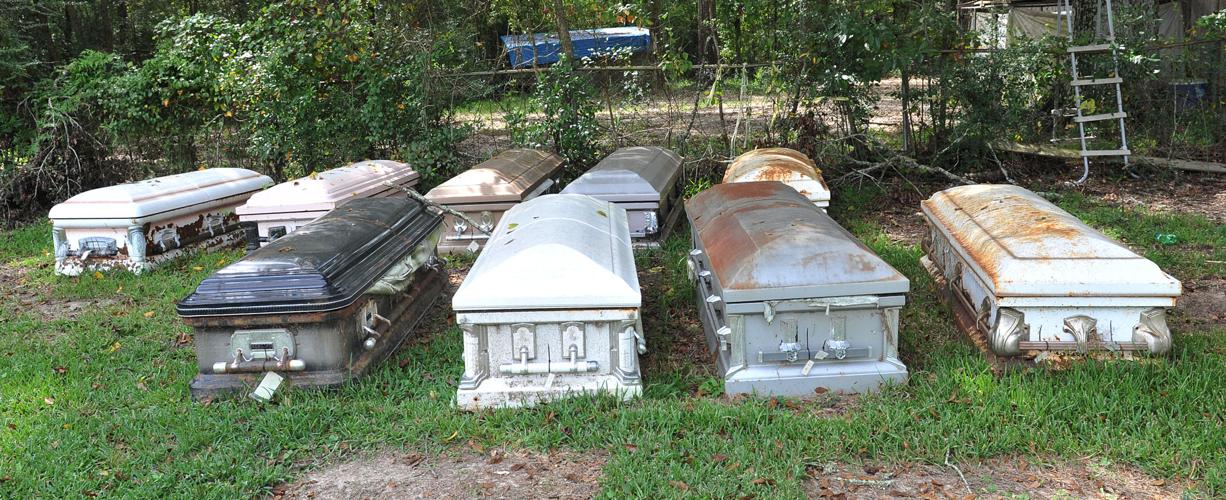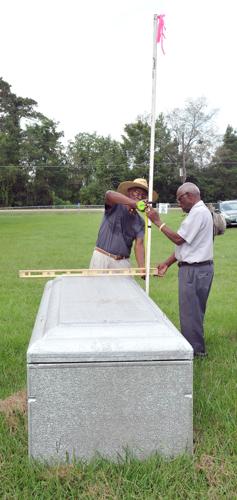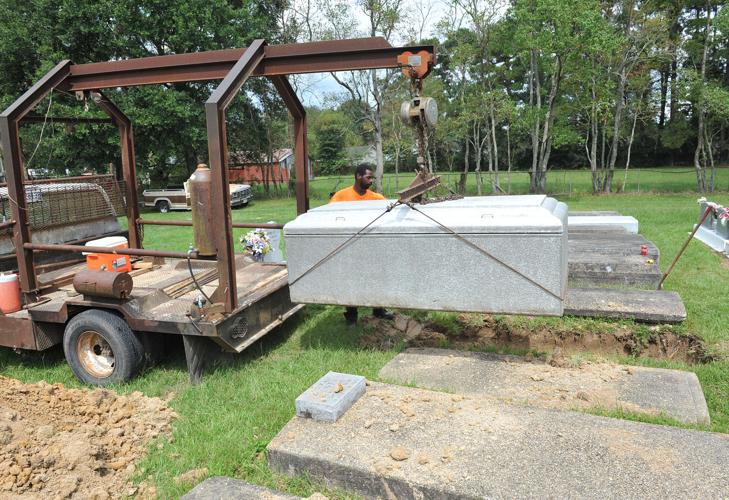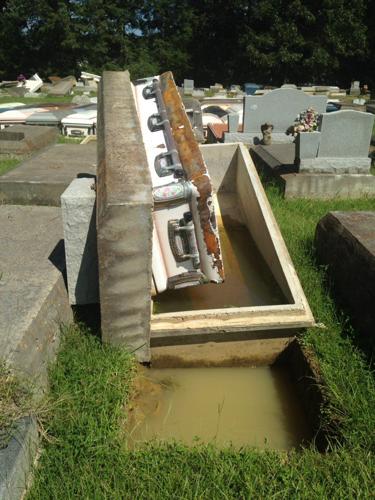DENHAM SPRINGS — A small backhoe inched past a row of stone vaults last week, stopping at a spot in the middle of the grassy Plainview Cemetery to dig a new grave.
It was time — at last — to start burying the 14 community members who died after the August 2016 floods. Their bodies temporarily have since laid in a row of vaults near the entrance, waiting for the graveyard to be restored so they could be buried in family plots.
Thirteen months ago, water rushed into the cemetery not far from the Amite River, cracking vaults, pushing caskets loose and toppling tombstones. Anthropologists, forensic scientists and dutiful church leaders then set to work on restoring the place, one of 74 cemeteries that flooded last fall in 19 parishes across southeast Louisiana.
Through a laborious process of identification and reconstruction, almost all of the 801 disturbed graves have been returned to their restful states, said Ryan Seidemann, chief of the lands and natural resources section in the civil division of the state Attorney General's office, which led the statewide effort.
"We're approaching the end," he said.
Of all the cemeteries affected by the flooding, Plainview Cemetery north of Denham Springs had it the worst. Nearly 300 of the 820 graves there were disturbed, with the remains of 119 people needing to be identified before they could be re-interred, Seidemann said. There are 40 graves left to fix and 15 caskets need to be identified — the only still unidentified remains from the August flood.
Can't see video below? Click here.
As time passes, it is probably "unavoidable" that some will need to be reburied in an unknown section, said Fred Banks, chairman of the Plainview cemetery board.
Marked graves at Plainview date back to 1927, but the predominantly black cemetery is even older than that. It originally also housed a church built in 1894 and the first primary school for black children in the area, said Lawrence Jordan, 87, a longtime member of Roberts United Methodist Church, which owns the cemetery.
He and his brother Morris, 88, have known the cemetery their whole lives. As kids, they brought water to their father as he dug the graves. This year, the brothers have been active in identifying the lost caskets, which floated away from the vaults that are partially above ground.
"It really hurt, because everybody in here, we know. We know the family of them. Denham Springs is a very small place. It hurt to see that happen," said Lawrence Jordan as he walked among the vaults, now dotted with newer concrete ones that are replacements since the flood.
The months-long efforts are still visible at Plainview. Sitting next to a subdivision that grew up much later than the cemetery, the graveyard — still closed to the public — has a fence and a sign that reads: "Department of Homeland Security, No Trespassing, Keep Out."
In the middle of the cemetery are two army tents, a semi-truck trailer, a dumpster and a pile of broken vaults.
Shortly after the floods in 2016, the attorney general's office started collecting reports to local governments about damaged graves across the state. Those reports are still trickling in, with somebody last week notifying them of disturbed graves at a rural Port Vincent graveyard.
A small team of people travels to each site to document the problems. At Plainview, water had inundated the low-lying grassy field. It caused 119 caskets to become separated from their tombstones and require identification, according to the attorney general's office. Few of those caskets had a name inscribed or attached to them.
Seidemann called in the LSU FACES lab, which assembled a team of forensic scientists and graduate students to help document the remains and caskets. Army tents were used as mini-laboratories for the forensic reviews.
They checked first for the most obvious clues: A hospital tag or a memory blanket with an embroidered name.
“When that would happen we would breath a sigh of relief,” said FACES lab director Ginesse Listi.
LIVINGSTON - The Livingston Parish Council may amend a new ordinance aimed at keeping burial…
When that failed — as it often did — they photographed the coffin and documented the remains inside. Helpful information included hairstyles, jewelry, scars, tattoos or mementos.
Working with leaders at local churches, the team — which included Seidemann, a research associate, a health department official and a specialist in disaster mortuary work — found community members who remembered and could identify the dead. The parish coroner also helped find those people.
In one case, a community member was able to identify a woman remembered for having severe osteoarthritis and rheumatoid arthritis, recalled Christine Halling, a research associate at the attorney general's office, who assisted with the project.
"We just had no leads. There was no family information. We couldn't get a hold of anybody from the church," she said. "But really starting to reach out with the community members and they remembered a whole lot of details that helped us get a positive identification."
Restoration of Plainview and the other cemeteries has been paid for primarily by the Federal Emergency Management Agency. Once a body was identified, a family member or friend had to claim it and file for individual assistance to repair the grave. Those checks, in amounts ranging from $500 to $2,000, needed to be turned over to Livingston Parish government, which arranged for a contractor to do the restoration work.
It was a process that Mark Harrell, director of the office of homeland security and emergency services, said could have been done faster and cheaper through the public assistance program, for which the parish would have paid ten percent. As it stands, the parish has had to coordinate with more than a hundred individuals to wrangle checks and coordinate construction.
Banks, chair of the Plainview Cemetery board, said he has been happy with the cooperation between the government agencies and the community. And he feels grateful that they were able to get the funding from FEMA to do the work.
The stories were stirring.
"It all fell in place," he said. "Hopefully, it won’t happen again."
Some measures have been put in place to help ensure there won't be a repeat. A new parish-wide ordinance requires information including the person's name, death date, cemetery name and burial plot location to be affixed to each casket. It also requires that the vault lids be secured to the vaults, which in turn must be secured to the ground. At Plainview, new vaults that replaced the broken ones are now marked with bar codes to track them.
Seidemann and Halling said they are looking now at how other states are tracking caskets.
"Broadly the state is looking at ways to deal with this, but nothing has been implemented in any kind of uniform fashion yet," Seidemann said.
Anyone who believes a friend or family member's grave was affected by the 2016 floods and has not yet made contact with authorities should contact Attorney General Jeff Landry's Office at 225-326-6000.












